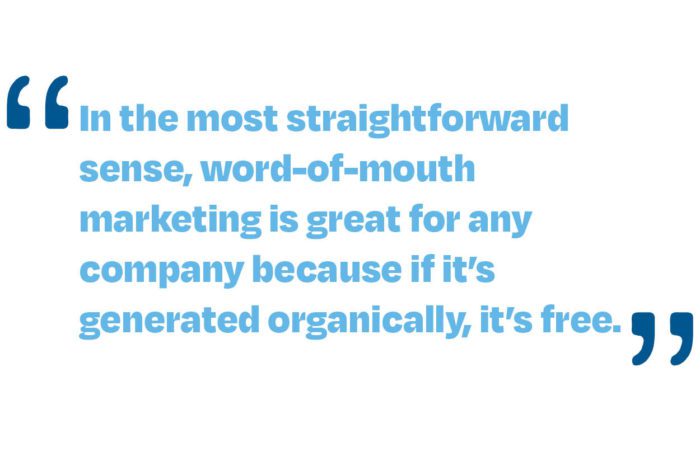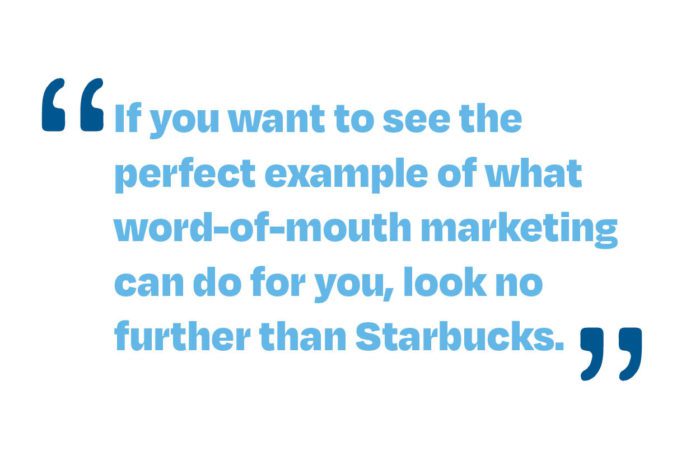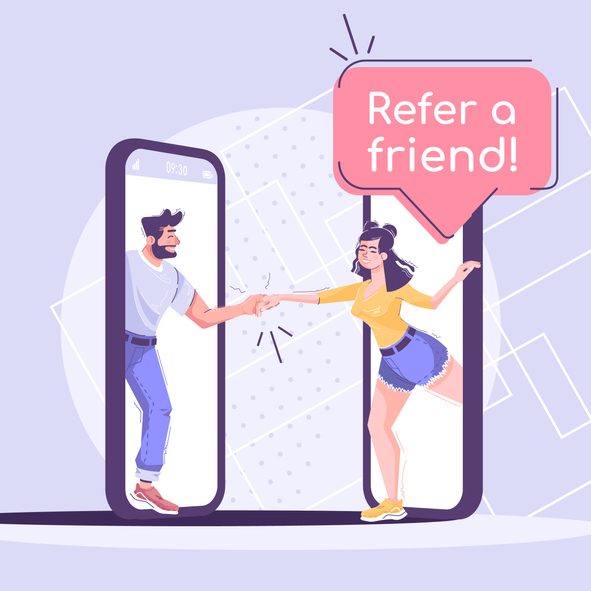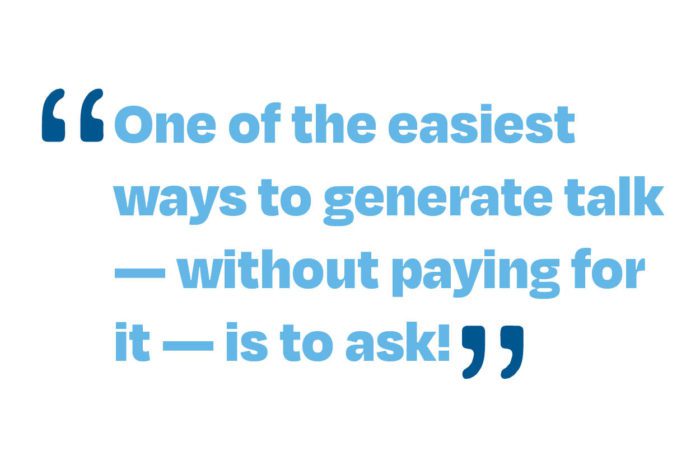Every year, marketers have an increasing number of tools at their disposal. The list of options is nearly infinite: social media, content marketing, influencer marketing, and many more. All of these strategies are valuable, and the best marketing plans are those that are multifaceted. In your rush to stay on top of the latest trends, however, don’t forget the eternal power of the oldest type of marketing: word-of-mouth marketing.

The Value Of Word-Of-Mouth Marketing
Why does word-of-mouth marketing continue to work so well? The answer is pretty simple. People believe their friends and family. In fact, a Nielsen study found that consumers put more stock in referrals from trusted sources than any other type of marketing. Across all regions of the world, “recommendations from people I know” ranked highest in terms of trusted marketing. The trend is the same across all age groups, including the millennials that companies covet most.
The days of being the only tailor in town are long gone. Consumers have plenty of options to find what they are looking for. These days, if you want to attract new customers, you need your current ones to be avid fans of your company. People share the brands they like on Facebook, and when they find something they love, it’s only natural they’d want to share it with their friends. If you aren’t taking advantage of this sharing, you’re missing a key page from your marketing playbook.
And word-of-mouth marketing isn’t just talk — it can be broken down further into organic and paid word-of-mouth marketing.
Organic Word-Of-Mouth Marketing
Organic word-of-mouth marketing is when happy customers naturally want to tell their friends or family about a great new product or service, so they tell them about your fantastic brand. This type of marketing occurs unprompted and is never a result of a monetary incentive — just a job well done!
This type of natural word-of-mouth marketing can happen either in person or online through reviews, social media shoutouts, and text messaging.
Paid Word-Of-Mouth Marketing
This type of word-of-mouth marketing is the opposite of organic in that a company generates it on purpose. It can be done by paying an influencer to share your product on their social media page or by offering customers a coupon, discount, or free item to bring in new customers to your company. This causes people to talk about your brand not so much for a job well done, but because you’re offering some sort of perk that other businesses aren’t, which is attractive to current and potential customers.
The Business Perks Of Word-Of-Mouth Marketing
In the most straightforward sense, word-of-mouth marketing is great for any company because if it’s generated organically, it’s free. By doing what you do best, happy customers will recruit their friends and family to your business, which is always better for your bottom line.

But besides its affordability, word-of-mouth marketing comes with other perks that will benefit your business.
It’s Proof That What You Sell Is Valuable And Legit.
In a world where 70% of Americans shop online, choosing where to do business has become an increasing concern as online consumers report that shopping on fraudulent sites is a major worry for them.
Word-of-mouth marketing negates those worries by showing that your business is legitimate and that you offer a darn good product too. If your product is as cool as you say it is, people will be talking about it. There’s nothing less convincing to a consumer than a business saying that its product is the best without real people to back it up. So, when a shopper sees that people just like them love a brand, they’re much more likely to believe that what the company is selling is high quality and will ultimately bring value to their life.
It Offers You Marketing Flexibility.
When you make a commercial or paid aid that feeds into someone’s social media dashboard, what you say there is static. You can’t change the words to appeal to every person because putting out different ads to target different audiences is just plain expensive.
Word-of-mouth marketing allows you to tailor many different messages to diverse audiences whenever you’d like. For instance, if you’re a meal-service brand, your primary audience may be people who want to avoid grocery shopping and don’t have much time to cook, so many of your more expensive advertisements target this audience. However, you may decide that you’d like to launch a campaign toward moms because a meal prep box is a great way to teach young children to measure and cook. So, instead of revamping your main marketing strategy, you can hire an influencer that’s popular among moms (these are called momfluencers, fun fact) to promote your product in a specific way to a niche audience. It’s a great way to generate business for a fraction of the cost.
Masters Of Word-Of-Mouth
If you want to see the perfect example of what word-of-mouth marketing can do for you, look no further than Starbucks. You’re probably within spitting distance of one right now — its empire extends to over 13,000 locations in the U.S.! What’s even more remarkable is that it achieved this dominance without using much traditional advertising at all. When was the last time you remember seeing a TV commercial for Starbucks?

Instead, they let their biggest customers spread the word. You probably know someone who could be described as a Starbucks evangelist. At every turn, they come up with new ways to make their brand shareworthy. The pumpkin spice craze? You can thank Starbucks for that. The unicorn frappuccino? A word-of-mouth marketing dream.
Of course, Starbucks isn’t the only example of a brand that kills it with word-of-mouth marketing. Check out these 6 companies that have seen similar success.
How To Get People Talking
After reading the statistics and seeing some real-world examples of word-of-mouth mastery, there’s probably one question on your mind: How can I get in on this? Well, like word-of-mouth marketing itself, the tactics to get people to share aren’t very complicated.
First, you need a quality product. The only word-of-mouth gossip consumers share about snake oil salesman is, “Don’t buy from that guy.” If you want people to rave about your product or service, it needs to be rave-worthy. When Starbucks arrived on the scene, they differentiated themselves by having a superior cup of coffee. It might seem like a distant memory now, but there was once a time when most people had no clue what the difference was between a cappuccino and a latte.

In addition to a product customers want to talk about, you need to create an experience. While nobody would step into a Starbucks if the coffee tasted like mud, their appeal is equally based on the atmosphere their stores create. Lots of people hold company meetings at coffee shops. Conversely, hosting a meeting in McDonald’s would seem absurd.
Creating an experience isn’t limited to building a comfortable retail space. Think about ways you can make your customers feel good about interacting with you. If they hang up on a customer service call feeling great, that’s providing an awesome experience. And there are other tactics your business can employ that utilize word-of-mouth marketing so that you can start the good gossip yourself.
Employ A Call To Action.
One of the easiest ways to generate talk — without paying for it — is to ask! Think about the times you tried a new experience, listened to a podcast, or attended an event, and the host asked the audience to leave them an online review or tell a friend. That small ask is generating word-of-mouth marketing. Even if a tiny percentage of the audience follows through, that’s still building that social proof potential customers are looking for.

Incentivize Referrals.
Many companies offer loyalty programs, and you can generate some word-of-mouth marketing of your own by offering an incentive for all referrals. For example, if a current customer recruits their friend, they get a certain percentage off their next purchase or a gift card. If you play your marketing right, this tactic can also increase referrals by only offering the incentive once the new recruit stays your customer for a certain amount of time.
Try Influencer Marketing.
One of the easiest ways to get in front of a lot of people at once is to have an influencer with thousands of followers post about your brand. When an online personality supports your product, talk is generated not only in the comments on the post but among their fan base as well. Often, these influencers can even give out referral links or codes that kick back a few bucks every time their followers buy one of your products, which will also incentivize the influencer to talk about your business more.
Offer Incentives For Reviews.
If your brand lacks reviews to show the value of your products or services, you can offer free goods or promotional codes to those who review your products. However, the important thing here is that the reviews cannot be required to be only positive. Paying people for fake positive reviews does your business no good and ultimately causes you to waste money and creates a liability. You want people to share the good, the bad, the great, and the ugly, so if you’re not hitting the mark that makes people want to tell everyone about your brand, you’ll be able to fix the issues and serve your customers better. Often, the people who take you up on this offer are the ones who have something nice to say anyway.

So ask people to give honest feedback and reward them for their honesty. Your business will be better for it.
Combining Word-Of-Mouth Marketing With Other Tactics
Word-of-mouth marketing doesn’t have to happen in the untrackable ether of person-to-person conversations. Social media in particular offers plenty of opportunities to structure word-of-mouth marketing endeavors. Encourage your customers to share their experiences with hashtags to aggregate their responses. If you create a clever campaign, you can be sure customers will give it a life of its own online.
Word-of-mouth marketing may not be new, but it dovetails perfectly with the buzzworthy concept of “shareability.” Whether the focus is on your product, the experience you create, or a campaign that encourages participation, getting people to share their positive feelings is the goal. Remember the ALS ice bucket challenge from a few years ago? That’s the perfect example of combining new tech with old-school word-of-mouth. In fact, there are a lot of lessons you can learn from this wildly successful campaign.
Make Your Brand Word-Of-Mouth Worthy
How you’ll generate word-of-mouth marketing will be unique to your brand. Ask yourself what makes your company special — and how to get people talking about it. From there, you’ll have a great foundation to develop a word-of-mouth marketing campaign that’s sure to get people talking. Who knows? Your brand might even go viral.
If you want to get people talking but aren’t sure how to take your business to the next level, we have the perfect resource for you. Our Content Marketing Guide is full of tips, tricks, and strategies to help your business create high-quality content that people won’t stop talking about. You can fill out the form below to download your free copy!


Recent Comments